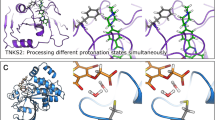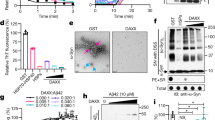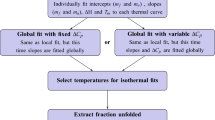Abstract
Protein folding in cells occurs in the presence of high concentrations of endogenous binding partners, and exogenous binding partners have been exploited as pharmacological chaperones. A combined mathematical modeling and experimental approach shows that a ligand improves the folding of a destabilized protein by biasing the kinetic partitioning between folding and alternative fates (aggregation or degradation). Computationally predicted inhibition of test protein aggregation and degradation as a function of ligand concentration are validated by experiments in two disparate cellular systems.
This is a preview of subscription content, access via your institution
Access options
Access Nature and 54 other Nature Portfolio journals
Get Nature+, our best-value online-access subscription
$29.99 / 30 days
cancel any time
Subscribe to this journal
Receive 12 print issues and online access
$259.00 per year
only $21.58 per issue
Buy this article
- Purchase on Springer Link
- Instant access to full article PDF
Prices may be subject to local taxes which are calculated during checkout


Similar content being viewed by others
References
Hingorani, K.S. & Gierasch, L.M. Curr. Opin. Struct. Biol. 24, 81–90 (2014).
Monteith, W.B., Cohen, R.D., Smith, A.E., Guzman-Cisneros, E. & Pielak, G.J. Proc. Natl. Acad. Sci. USA 112, 1739–1742 (2015).
Guzman, I. & Gruebele, M. J. Phys. Chem. B 118, 8459–8470 (2014).
Powers, E.T., Powers, D.L. & Gierasch, L.M. Cell Rep. 1, 265–276 (2012).
Bershtein, S., Choi, J.M., Bhattacharyya, S., Budnik, B. & Shakhnovich, E. Cell Rep. 11, 645–656 (2015).
Jahn, T.R. & Radford, S.E. Arch. Biochem. Biophys. 469, 100–117 (2008).
Parenti, G., Andria, G. & Valenzano, K.J. Mol. Ther. 23, 1138–1148 (2015).
Sontag, E.M., Vonk, W.I. & Frydman, J. Curr. Opin. Cell Biol. 26, 139–146 (2014).
Baccanari, D.P., Daluge, S. & King, R.W. Biochemistry 21, 5068–5075 (1982).
Cho, Y. et al. Cell Rep. 11, 321–333 (2015).
Ishii, S. et al. Biochem. J. 406, 285–295 (2007).
Fan, J.Q., Ishii, S., Asano, N. & Suzuki, Y. Nat. Med. 5, 112–115 (1999).
Sakuraba, H. et al. Am. J. Hum. Genet. 47, 784–789 (1990).
Asano, N. et al. Eur. J. Biochem. 267, 4179–4186 (2000).
Main, E.R., Fulton, K.F. & Jackson, S.E. J. Mol. Biol. 291, 429–444 (1999).
Banaszynski, L.A., Chen, L.C., Maynard-Smith, L.A., Ooi, A.G. & Wandless, T.J. Cell 126, 995–1004 (2006).
Clancy, J.P. et al. Thorax 67, 12–18 (2012).
Lukacs, G.L. et al. EMBO J. 13, 6076–6086 (1994).
Van Goor, F. et al. Proc. Natl. Acad. Sci. USA 108, 18843–18848 (2011).
Pankow, S. et al. Nature 528, 510–516 (2015).
Tokuriki, N. & Tawfik, D.S. Nature 459, 668–673 (2009).
Gershenson, A., Gierasch, L.M., Pastore, A. & Radford, S.E. Nat. Chem. Biol. 10, 884–891 (2014).
Corcos, D. et al. Blood 115, 282–288 (2010).
Bystroff, C., Oatley, S.J. & Kraut, J. Biochemistry 29, 3263–3277 (1990).
Guce, A.I., Clark, N.E., Rogich, J.J. & Garman, S.C. Chem. Biol. 18, 1521–1526 (2011).
Ionescu, R.M., Smith, V.F., O'Neill, J.C. Jr. & Matthews, C.R. Biochemistry 39, 9540–9550 (2000).
Watson, M., Liu, J.W. & Ollis, D. FEBS J. 274, 2661–2671 (2007).
Luo, S., Wehr, N.B. & Levine, R.L. Anal. Biochem. 350, 233–238 (2006).
Acknowledgements
We thank C.R. Matthews (University of Massachusetts Medical School, Worcester) for providing us with a plasmid containing the wild-type, cysteine-free E. coli DHFR gene. This work was supported by NIH grants GM101644 to L.M.G. and E.T.P. and DK76877 to S.C.G.
Author information
Authors and Affiliations
Contributions
K.S.H., L.M.G., E.T.P., and S.C.G. conceived the experiments. K.S.H. performed the experiments with dDHFR. K.S.H., M.C.M., and D.T.D. performed the experiments with R301Q α-GAL. E.T.P. developed the mathematical model. All authors contributed to the experimental design, data analysis, and manuscript preparation.
Corresponding authors
Ethics declarations
Competing interests
The authors declare no competing financial interests.
Supplementary information
Supplementary Text and Figures
Supplementary Results, Supplementary Figures 1–5 and Supplementary Note. (PDF 1615 kb)
Rights and permissions
About this article
Cite this article
Hingorani, K., Metcalf, M., Deming, D. et al. Ligand-promoted protein folding by biased kinetic partitioning. Nat Chem Biol 13, 369–371 (2017). https://doi.org/10.1038/nchembio.2303
Received:
Accepted:
Published:
Issue Date:
DOI: https://doi.org/10.1038/nchembio.2303
This article is cited by
-
Illuminating chaperone activity
Nature Chemical Biology (2017)



